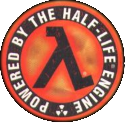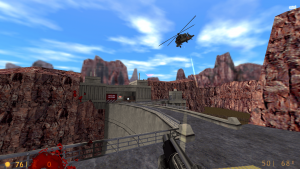GoldSrc
(SDK v2.5 source code & bug reports)
SDK v2.4 on GitHub (
steam_legacy branch) GoldSrc tutorials on TWHL
![]() GoldSrc (also known as GoldSource, and formerly just the Half-Life Engine) is a 3D video game engine created by Valve in 1996. It was the driving force behind many famous games of the late 90s and early 00s, such as Half-Life, Team Fortress Classic, Counter-Strike, and Day of Defeat. GoldSrc is a heavily modified version of the Quake engine and runs on C++ (with some "C" code). GoldSrc and its level editor, Valve Hammer Editor, were released by Valve for public use, making it the source of countless community-made modifications.
GoldSrc (also known as GoldSource, and formerly just the Half-Life Engine) is a 3D video game engine created by Valve in 1996. It was the driving force behind many famous games of the late 90s and early 00s, such as Half-Life, Team Fortress Classic, Counter-Strike, and Day of Defeat. GoldSrc is a heavily modified version of the Quake engine and runs on C++ (with some "C" code). GoldSrc and its level editor, Valve Hammer Editor, were released by Valve for public use, making it the source of countless community-made modifications.
GoldSrc was replaced by its successor, ![]() Source, in 2004, which currently holds first place as the choice engine for Valve modders. Though GoldSrc is past its prime, many gamers and some third-party developers still seek to use it for mods and level design.
Source, in 2004, which currently holds first place as the choice engine for Valve modders. Though GoldSrc is past its prime, many gamers and some third-party developers still seek to use it for mods and level design.
The engine is actively being updated and maintained by Valve as of 2023, recently with the Half-Life's 25th-anniversary updates which increased the engine limits and fixed many bugs.
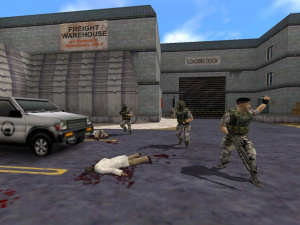
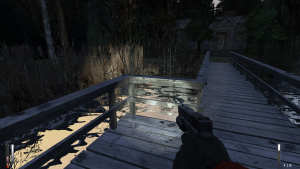
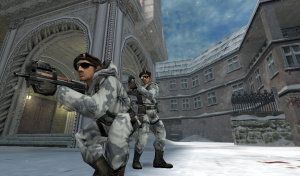

Contents
Features
Renderer
GoldSrc has two in-game renderers Software Renderer and OpenGL (previously three as Direct3D 6 support was removed in the 2013 SteamPipe Update) both renderers have differences.
- Colored lighting - Quake simply had monotone lighting
- Transparent textures - Glass can now be used in maps
- Transparent Water
- Water ripple
- Water waves
- Dynamic iris simulation - adjust screen brightness automatically. A feature similar to Source's HDR Rendering. (only in
 )
) - Texture Filtering - First introduced with GLQuake, a version of Quake that runs on OpenGL.
- Anisotropic filtering (16x by default) supported since the 2013 SteamPipe update.
- Skeletal animation - allowing for more stable animation of models, compared to the vertex animation in Quake
- Higher poly counts - GoldSrc allows for far more detailed models than Quake
- HD models - Higher polygon and texture quality for in-game models.
- Detailed textures (only in





 )
)
Since 2013 SteamPipe Update
- FBO renderer - A new method of rendering the game, which allows MSAA to work with GoldSrc engine. This also allows the game to run on fullscreen in a borderless window (which also makes Alt+Tab faster), and aspect ratio that are different from your monitors, for example, 4:3 on 16:9, will not be stretched to fill the black bars.
-nofbo command line, note that this will also disable MSAA.- MSAA anti-aliasing - GoldSrc now natively support anti-aliasing, specifically, MSAA 4X, which is enabled by default on most modern hardwares. This will reduce the amount of jagged edges/staircases effect on the geometry.
- Support for Anisotropic filtering - Increases visual quality of textures at steep angles to the camera. GoldSrc uses 16x Aanisotropic filtering by default.
Since 25th Anniversary
- Widescreen "Hor+" FOV
- Instead of cropping the image and reducing FOV when using widescreen, the image will be expanded.
- Shaders support (OpenGL)
- With shaders support, it also fix the issues with overbright lighting not working under OpenGL.
- Dynamic Shadows
r_shadows must be set to 1- Software Renderer support on Linux
AI
- AI flocking - NPCs can group together, seen with Houndeyes.
- Scripted sequences - Used extensively to tell Half-Life's story.
- Player Bots - play multiplayer offline with bots. (only in

 )
)
Sound System
- Supports MP3 (since 2003), WAV audio files, aswell as CD audio.
- Hardware accelerated audio (A3D/EAX) - improves DSP sound effects (such as removing echo's buzzing noises), and add surround sounds support (Removed since 2013 SteamPipe update).
- Requires Sound Blaster-compatible (or A3D-compatible) sound cards (but can be bypassed using workaround below).
- While support for A3D/EAX was removed in most GoldSrc games since SteamPipe update (but can be restored using MetaAudio, which requires disabling VAC to work), there are some GoldSrc games that still support A3D/EAX. However, starting with Windows Vista or later, it requires an workaround to enable A3D/EAX audio.
UI
- VGUI2 - Introduced in 2003 update (Steam), Valve's custom GUI interface mimics most of the Windows controls. This will allow the game to switch between the game and the menu quicker, without switching resolutions to 640x480, which adds delay.
Programming and Platforms
- GoldSrc supports various platforms, such as Windows, macOS and Linux, aswell as consoles (PlayStation 2, Original Xbox).
- All, or most of the engine code written on C/C++ using Visual Studio 2010, and 2019 (since 25th anniversary) or later.
Tools
 Hammer 3.x (formerly Worldcraft)
Hammer 3.x (formerly Worldcraft)
- WYSIWYG World editor
- Create world brushes
- Place AI NPCs
- Place triggers, clip brushes, logic, etc.
- Allows level designer to hook up I/O between entities to control AI within the game
 Note:While it's functional, it is recommend to use modern third-party alternatives (such as J.A.C.K.) instead.
Note:While it's functional, it is recommend to use modern third-party alternatives (such as J.A.C.K.) instead.
 Half-Life Model Viewer
Half-Life Model Viewer
- Full model previewer
- Rotate models in any direction
- Set up hit boxes
- View physics hull
- View normals
- Wireframe, shaded or textured view modes
- StudioMDL
- Model compiler
- QCSG, QBSP2, QRAD, VIS
- Map compilation tools (bsp, lighting and visibility)
Other
- In-game advertisements (
 Counter-Strike, removed since SteamPipe) - Introduced in 2007.
Counter-Strike, removed since SteamPipe) - Introduced in 2007.
Since 25th Anniversary
- Increased engine limits - Valve has increased engine limitations, allowing for more entities and detailed maps.
- func_vehicle entity support from
 Counter-Strike
Counter-Strike - Native
 Steam Deck support
Steam Deck support - Steam Input support - Steam Input support was added, which allows the game to support more controllers and buttons. VGUI menu can be navigated using the controller.
Versions and forks
For help, see the VDC Editing Help and Wikipedia cleanup process. Also, remember to check for any notes left by the tagger at this article's talk page.
| Year | Version | Company | Features | Base | Notes |
|---|---|---|---|---|---|
| 1998 [Clarify] | v1.0.x.x/SDK v1 | Per-texture palettes, Coloured lighting | Quake (id Tech 2) | v30 .bsp, v10 .mdl | |
| 1998[Clarify] | v1.1.x.x/SDK v2.0 | VGUI | v1.0.x.x/SDK v1 | v30 .bsp, v10 .mdl | |
| 2001 (leak)[Clarify] | Dreamcast | Compressed model textures | v1.1.x.x/SDK v2.0 | v30 .bsp, v11 .mdl | |
| 2002 | 007 Nightfire | Direct3D 8 renderer MSAA support |
v1.1.x.x/SDK v2.0 (For PC) Modified id Tech 3 (For consoles)[citation needed] |
v42 .bsp, v14 .mdl | |
| 2003 | PlayStation 2 | LOD models | Dreamcast | v40 .bs2, v10 .dol | |
| 2003 | Xbox | Improved lighting | Counter-Strike: Condition Zero engine branch earlier version | v30 .bsp, v11 .mdl, .sxwad format instead of wad | |
| 2003 | Counter-Strike Neo engine branch | Namco | Heavily modified OpenGL Renderer Native linux support |
v1.1.x.x/SDK v2.0 Counter-Strike: Condition Zero engine branch (ver.2) |
v30 .bsp, v10 .mdl [confirm] |
| 2003 | Steam | VGUI2 Widescreen resolution support |
v1.1.x.x/SDK v2.0 | v30 .bsp, v10 .mdl | |
| 2004 | Counter-Strike: Condition Zero engine branch | Player Bots Detail textures |
v1.1.x.x/SDK v2.0[confirm] | v30 .bsp, v10 .mdl [confirm] | |
| 2007[Clarify] | Paranoia Team | New OpenGL Renderer | Counter-Strike: Condition Zero engine branch | v30 .bsp, v10 .mdl [confirm] | |
| 2013 | Team Psykskallar | Improved paranoia's OpenGL Renderer | v30 .bsp, v10 .mdl [confirm] | ||
| 2013 | 2013 SteamPipe (SDK 2.4) | Linux and Mac support FBO renderer MSAA (4X) support Removed support for EAX/A3D surround sound and Direct3D 7 renderer |
Steam | v30 .bsp, v10 .mdl | |
| 2016 | Sven Co-op Team | AngelScript FMOD audio (restores EAX/surround sound features) Extended engine limits |
2013 SteamPipe | v30 .bsp, v10 .mdl | |
| 2023 | 25th anniversary, aka HL25 (SDK 2.5) | Increased engine limit Steam Input Shaders Widescreen (Hor+) FOV |
2013 SteamPipe | v30 .bsp, v10 .mdl |
Half-Life SDK
As of August 2013, it is available on ![]() Steam under the "Tools" section. With it comes
Steam under the "Tools" section. With it comes ![]() Hammer 3.4, the 3ds Max sources for many cut and retail NPCs as well as player and weapon models, tools for packing textures into WADs, and detailed documentation on implementing baseline features such as voice chat into a mod.
Hammer 3.4, the 3ds Max sources for many cut and retail NPCs as well as player and weapon models, tools for packing textures into WADs, and detailed documentation on implementing baseline features such as voice chat into a mod.
The full source code for Half-Life SDK (2.5), which contains changes from Half-Life 25th anniversary update, can be found on Valve's GitHub Page. Source code for previous version (SDK 2.4) can be found here.
Products using GoldSrc 



| Year | Title | Developer(s) | Publisher(s) | Platforms | Notes |
|---|---|---|---|---|---|
1998 |
|
Valve | Sierra Entertainment (retail) Valve (digital) |
PC: Windows, Mac, Linux Console(s): PlayStation 2 |
First official game to use the GoldSrc engine. The The game received a major update in November 17, 2023, for it's 25th anniversary, which fixes tons of bugs, added new maps and content and increased engine limits. |
1999 |
|
Gearbox Software, Valve | PC: Windows, Mac, Linux | First official expansion for |
|
| |
Valve | PC: Windows, Mac, Linux | Remake of Quake mod, |
||
| |
Sven Co-op Team | Sven Co-op Team | PC: Windows, Mac, Linux | GoldSrc was later forked into Svengine since version 5.0, which was slightly different than GoldSrc, and has support for Hor+ FOV, better audio via FMOD, and so on..., aswell as increased engine limitations. Sven Co-op is a co-op mod that allows you to play |
|
2000 |
|
Valve | Sierra Entertainment (retail) Valve (digital) |
PC: Windows, Mac, Linux | Originally was an Half-Life mod, it was later available to purchase seperately from Half-Life. The game later become popular when it was released and kickstart several tournaments involving Counter-Strike games. |
| |
Rewolf Entertainment | Sierra Entertainment | PC: Windows | ||
| |
Valve | Valve | PC: Windows, Mac, Linux | ||
2001 |
|
PC: Windows, Mac, Linux | |||
| |
Gearbox Software, Valve | Sierra Entertainment (retail) Valve (digital) |
PC: Windows, Mac, Linux | Second official expansion to the original Half-Life, aswell was set hours earlier and during the event of Half-Life. Players play as Barney Carlhoun, who later returned in Half-Life 2 series. | |
| |
Maverick Developments | Maverick Developments | PC: Windows | ||
| |
Gearbox Software | Sierra Entertainment | PC: Windows (unofficial) Console(s): PlayStation 2 |
Half-Life last expansion, exclusive to PlayStation 2. An unofficial port of Half-Life Decay for PC developed by Hoaxer, was released in 2008. | |
2002 |
|
Unknown Worlds | Unknown Worlds | PC: Windows | |
| |
Eurcom, Gearbox Software (PC) | Electronic Arts | PC: Windows, Mac (PowerPC) Console(s): PlayStation 2, Original Xbox, GameCube, Game Boy Advance |
Highly modified engine with MSAA support (up to 8X) and Direct3D 8 (DX8). Consoles version uses entirely different engines, and have more content than PC version. Also only GoldSrc game to be ported to PowerPC-based Mac (Half-Life port to PPC Mac was cancelled). |
|
2003 |
|
Valve | Activision, Valve (digital) | PC: Windows, Mac, Linux | |
| |
Ritual Entertainment, Turtle Rock Studios | Xbox Game Studios (formerly Microsoft Studios) | PC: Windows Consoles: Original Xbox |
||
| |
Namco | Namco | PC (Arcade) | ||
2004 |
|
Valve, Ritual Entertainment, Gearbox Software, Turtle Rock Studios | Sierra Entertainment, Valve (digital) | PC: Windows, Mac, Linux | Last Valve game to be developed on GoldSrc engine (CS Online and Nexon Studio does not count). |
2007 |
|
Paranoia Team | Paranoia Team | PC: Windows, Mac, Linux | Features modified OpenGL renderer for better graphics, downside of this is that the custom OpenGL renderer file "opengl32.dll" may get deleted by the game when launching any GoldSrc game outside Paranoia or prevents the player from playing multiplayer (due to |
2008 |
|
Valve, Nexon | Nexon | PC: Windows | Free to play game based off This version doesn't require Steam, and is only available in Asia. The console commands has been restricted to only some commands to prevent cheating and other exploits. |
2013 |
|
Team Psykskallar | Team Psykskallar | PC: Windows, Mac, Linux | Runs on older, but highly modified version of GoldSrc (based off |
2014 |
|
Valve, Nexon | Nexon | PC: Windows | Last officially licensed game to use the GoldSrc engine. Worldwide (America, Europe) version of |
2015 |
Headcrab Frenzy! | Crystice Softworks | PC: Windows, Linux | ||
2020 |
Halfquake Trilogy | Philipp Lehner | PC: Windows | ||
| Digital Paintball Redux | DPB Redux Dev Team | PC: Windows | |||
| |
Cobalt-57 | PC: Windows | |||
2023 |
|
MMod Team | Gunship_Mark_II | PC: Windows, Linux | |
| Year | Title | Developer(s) | Publisher(s) | Platforms | Notes |
- See GoldSrc games category for more games, and for articles about the game which uses the GoldSrc engine.
Specifications
| Limits | GoldSrc Pre-25th | GoldSrc Post-25th | ||
|---|---|---|---|---|
| Maximum number of dynamic sound channels | 8 | 32 | 64 | N/A |
Default max number of server entities (MAX_EDICTS) |
900 | 1200 | 600 - 8192 | 8192 |
| Absolute max number of server entities (via liblist.gam edits) | 2048 | 2048 | 8192 | N/A |
Maximum number of temporary entities (MAX_TEMPENTS) |
500 | N/A | 300 - 2048 | N/A |
Maximum number of particles (MAX_PARTICLES) |
4096 | N/A | 1024 - 131072 | N/A |
Maximum number of beams (MAX_BEAMS) |
64 | N/A | 64 - 512 | 256 |
Maximum number of visible entities in the package (MAX_VISIBLE_PACKET) |
256 | 1024 | 2048 | N/A |
Maximum number of pre-cacheable models and sprites (MAX_MODELS) |
512 | N/A | 1024 (4096 in FWGS) | 8192 |
Maximum number of pre-cached sounds (MAX_SOUNDS) |
512 | N/A | 2048 | 4096 |
Maximum number of entries to read sentences made up of sentences (MAX_SENTENCES) |
1536 | 2048 | 4096 | N/A |
Maximum number of user messages (MAX_USER_MESSAGES) |
128 | N/A | 191 | N/A |
Max number of loaded textures (MAX_TEXTURES) |
2048 | N/A | 4096 (8192 in FWGS) | N/A |
Max number of GL textures (MAX_GLTEXTURES) |
4800 | 10000 | 4096 (8192 in FWGS) | N/A |
Number of messages titles.txt (MAX_MESSAGES) |
1024 | N/A | 2048 | N/A |
| Maximum size of indexed textures | 512х512 | 512x512 | 8192х8192 | N/A |
| Maximum size of full color textures | 512х512 | 512x512 | 8192х8192 | N/A |
Maximum number of models on the map (MAX_MAP_MODELS) |
256 | N/A | 768 (1024 in FWGS) | 4096 |
Maximum number of map leafs (MAX_MAP_LEAFS) |
8192 | N/A | 32767 | 65536 |
Maximum number of entities per packet (MAX_PACKET_ENTITIES) |
256 | 1024 | 256 | 512 |
| Maximum number of spans (software renderer geometry limit) | 3000 | 6000 | N/A | N/A |
| Maximum number of surfaces (software renderer geometry limit) | 2000 | 4000 | N/A | N/A |
| Maximum number of edges (software renderer geometry limit) | 7200 | 14400 | N/A | N/A |
Bugs and Limitations
Use GitHub in order to prevent duplicate or outdated bug reports at the wiki.
Other games like
steam_legacy on Half-Life (and in some games such as Counter-Strike) by going to Half-Life > Properties... > Betas > select steam_legacy. Once those games has been fixed, you can opt out by set the beta branch to "None".gl_overbright 1) is broken due to an OpenGL extension used for multi-texturing, which is required for the detail textures used by This make the color less saturated and lighting much less brighter, as well as introduce chromatic aberration on brightly lit lightmaps.
The issue was fixed in the 25th anniversary update, which deprecated the
gl_overbright 1 in favor of gl_use_shaders 1. However, there are more issues that was yet to be fixed with the new overbright lighting.This issue can be also found on GLQuake, but for different reasons.
steam_legacy branch) and most standalone mods, see - Set the game (

hl.exe) to "High Priority" in Task Manager.  Disable multitexturing.
Disable multitexturing.
hl.dll and client.dll) on the mod folder itself was renamed. But keep in mind that this method may breaks some mods and cause it to crash, or made several new additions such as new weapons, new NPCs, etc... from the mod stops working.Trivia
- The term "GoldSrc" comes from development of the Source engine. A few months before the release of Half-Life, the Half-Life engine's source code was split into two branches: Src and GoldSrc. The GoldSrc branch was the gold master version of the codebase, and would be used for the proper release of the game. The Src branch, comparatively, would be continually iterated upon, adding and changing features for use in the sequel, with the term "Source Engine" eventually being picked up by marketing.[1]
See also
- For information about converting GoldSrc content to the Source engine, see Porting GoldSrc content (maps, models, etc.) to Source
- GoldSrc on Wikipedia
- GoldSrc SDK (Half-Life SDK) Documentation
- GoldSrc SteamPipe Directories
External links
- Source code + GitHub Issues - bug reports and the GoldSrc source code can be found here.
References
- User talk:Erik Johnson (Revision as of 12:53, 1 September 2005)
- Half-Life 25th Anniversary Update
- Relation between Paranoia & COF
